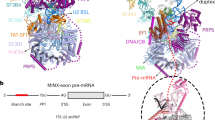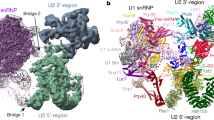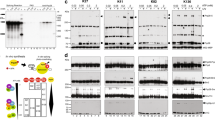Abstract
The spliceosome is a highly dynamic machine requiring multiple RNA-dependent ATPases of the DExD/H-box family. A fundamental unanswered question is how their activities are regulated. Brr2 function is necessary for unwinding the U4/U6 duplex, a step essential for catalytic activation of the spliceosome. Here we show that Brr2-dependent dissociation of U4/U6 snRNAs in vitro is activated by a fragment from the C terminus of the U5 snRNP protein Prp8. In contrast to its helicase-stimulating activity, this fragment inhibits Brr2 U4/U6-dependent ATPase activity. Notably, U4/U6 unwinding activity is not stimulated by fragments carrying alleles of prp8 that in humans confers an autosomal dominant form of retinitis pigmentosa. Because Brr2 activity must be restricted to prevent premature catalytic activation, our results have important implications for fidelity maintenance in the spliceosome.
This is a preview of subscription content, access via your institution
Access options
Subscribe to this journal
Receive 12 print issues and online access
$189.00 per year
only $15.75 per issue
Buy this article
- Purchase on Springer Link
- Instant access to full article PDF
Prices may be subject to local taxes which are calculated during checkout





Similar content being viewed by others
References
Staley, J.P. & Guthrie, C. Mechanical devices of the spliceosome: motors, clocks, springs, and things. Cell 92, 315–326 (1998).
Bleichert, F. & Baserga, S.J. The long unwinding road of RNA helicases. Mol. Cell 27, 339–352 (2007).
Cordin, O., Banroques, J., Tanner, N.K. & Linder, P. The DEAD-box protein family of RNA helicases. Gene 367, 17–37 (2006).
Rogers, G.W. Jr, Komar, A.A. & Merrick, W.C. eIF4A: the godfather of the DEAD box helicases. Prog. Nucleic Acid Res. Mol. Biol. 72, 307–331 (2002).
Shen, J., Zhang, L. & Zhao, R. Biochemical characterization of the ATPase and helicase activity of UAP56, an essential pre-mRNA splicing and mRNA export factor. J. Biol. Chem. 282, 22544–22550 (2007).
Laggerbauer, B., Achsel, T. & Luhrmann, R. The human U5–200kD DEXH-box protein unwinds U4/U6 RNA duplices in vitro. Proc. Natl. Acad. Sci. USA 95, 4188–4192 (1998).
Wang, Y. & Guthrie, C. PRP16, a DEAH-box RNA helicase, is recruited to the spliceosome primarily via its nonconserved N-terminal domain. RNA 4, 1216–1229 (1998).
Schwer, B. & Gross, C.H. Prp22, a DExH-box RNA helicase, plays two distinct roles in yeast pre-mRNA splicing. EMBO J. 17, 2086–2094 (1998).
Wagner, J.D., Jankowsky, E., Company, M., Pyle, A.M. & Abelson, J.N. The DEAH-box protein PRP22 is an ATPase that mediates ATP-dependent mRNA release from the spliceosome and unwinds RNA duplexes. EMBO J. 17, 2926–2937 (1998).
Tanaka, N., Aronova, A. & Schwer, B. Ntr1 activates the Prp43 helicase to trigger release of lariat-intron from the spliceosome. Genes Dev. 21, 2312–2325 (2007).
Tanaka, N. & Schwer, B. Mutations in PRP43 that uncouple RNA-dependent NTPase activity and pre-mRNA splicing function. Biochemistry 45, 6510–6521 (2006).
Staley, J.P. & Guthrie, C. An RNA switch at the 5′ splice site requires ATP and the DEAD box protein Prp28p. Mol. Cell 3, 55–64 (1999).
Mayas, R.M., Maita, H. & Staley, J.P. Exon ligation is proofread by the DExD/H-box ATPase Prp22p. Nat. Struct. Mol. Biol. 13, 482–490 (2006).
Xu, Y.Z. & Query, C.C. Competition between the ATPase Prp5 and branch region-U2 snRNA pairing modulates the fidelity of spliceosome assembly. Mol. Cell 28, 838–849 (2007).
Burgess, S.M. & Guthrie, C. A mechanism to enhance mRNA splicing fidelity: the RNA-dependent ATPase Prp16 governs usage of a discard pathway for aberrant lariat intermediates. Cell 73, 1377–1391 (1993).
Couto, J.R., Tamm, J., Parker, R. & Guthrie, C. A trans-acting suppressor restores splicing of a yeast intron with a branch point mutation. Genes Dev. 1, 445–455 (1987).
Lauber, J. et al. The HeLa 200 kDa U5 snRNP-specific protein and its homologue in Saccharomyces cerevisiae are members of the DEXH-box protein family of putative RNA helicases. EMBO J. 15, 4001–4015 (1996).
Xu, D., Nouraini, S., Field, D., Tang, S.J. & Friesen, J.D. An RNA-dependent ATPase associated with U2/U6 snRNAs in pre-mRNA splicing. Nature 381, 709–713 (1996).
Kim, D.H. & Rossi, J.J. The first ATPase domain of the yeast 246-kDa protein is required for in vivo unwinding of the U4/U6 duplex. RNA 5, 959–971 (1999).
Noble, S.M. & Guthrie, C. Identification of novel genes required for yeast pre-mRNA splicing by means of cold-sensitive mutations. Genetics 143, 67–80 (1996).
Raghunathan, P.L. & Guthrie, C. RNA unwinding in U4/U6 snRNPs requires ATP hydrolysis and the DEIH-box splicing factor Brr2. Curr. Biol. 8, 847–855 (1998).
Madhani, H.D. & Guthrie, C. A novel base-pairing interaction between U2 and U6 snRNAs suggests a mechanism for the catalytic activation of the spliceosome. Cell 71, 803–817 (1992).
Small, E.C., Leggett, S.R., Winans, A.A. & Staley, J.P. The EF-G-like GTPase Snu114p regulates spliceosome dynamics mediated by Brr2p, a DExD/H box ATPase. Mol. Cell 23, 389–399 (2006).
Bartels, C., Klatt, C., Luhrmann, R. & Fabrizio, P. The ribosomal translocase homologue Snu114p is involved in unwinding U4/U6 RNA during activation of the spliceosome. EMBO Rep. 3, 875–880 (2002).
Brow, D.A. Allosteric cascade of spliceosome activation. Annu. Rev. Genet. 36, 333–360 (2002).
Grainger, R.J. & Beggs, J.D. Prp8 protein: at the heart of the spliceosome. RNA 11, 533–557 (2005).
Boon, K.L., Norman, C.M., Grainger, R.J., Newman, A.J. & Beggs, J.D. Prp8p dissection reveals domain structure and protein interaction sites. RNA 12, 198–205 (2006).
Pena, V., Liu, S., Bujnicki, J.M., Luhrmann, R. & Wahl, M.C. Structure of a multipartite protein-protein interaction domain in splicing factor prp8 and its link to retinitis pigmentosa. Mol. Cell 25, 615–624 (2007).
Zhang, L. et al. Crystal structure of the C-terminal domain of splicing factor Prp8 carrying retinitis pigmentosa mutants. Protein Sci. 16, 1024–1031 (2007).
Bellare, P., Kutach, A.K., Rines, A.K., Guthrie, C. & Sontheimer, E.J. Ubiquitin binding by a variant Jab1/MPN domain in the essential pre-mRNA splicing factor Prp8p. RNA 12, 292–302 (2006).
Mordes, D. et al. Pre-mRNA splicing and retinitis pigmentosa. Mol. Vis. 12, 1259–1271 (2006).
Boon, K.L. et al. prp8 mutations that cause human retinitis pigmentosa lead to a U5 snRNP maturation defect in yeast. Nat. Struct. Mol. Biol. 14, 1077–1083 (2007).
van Nues, R.W. & Beggs, J.D. Functional contacts with a range of splicing proteins suggest a central role for Brr2p in the dynamic control of the order of events in spliceosomes of Saccharomyces cerevisiae. Genetics 157, 1451–1467 (2001).
Pena, V., Rozov, A., Fabrizio, P., Luhrmann, R. & Wahl, M.C. Structure and function of an RNase H domain at the heart of the spliceosome. EMBO J. 27, 2929–2940 (2008).
Ritchie, D.B. et al. Structural elucidation of a PRP8 core domain from the heart of the spliceosome. Nat. Struct. Mol. Biol. 15, 1199–1205 (2008).
Yang, K., Zhang, L., Xu, T., Heroux, A. & Zhao, R. Crystal structure of the β-finger domain of Prp8 reveals analogy to ribosomal proteins. Proc. Natl. Acad. Sci. USA 105, 13817–13822 (2008).
Rigaut, G. et al. A generic protein purification method for protein complex characterization and proteome exploration. Nat. Biotechnol. 17, 1030–1032 (1999).
Martinez-Gimeno, M. et al. Mutations in the pre-mRNA splicing-factor genes PRPF3, PRPF8, and PRPF31 in Spanish families with autosomal dominant retinitis pigmentosa. Invest. Ophthalmol. Vis. Sci. 44, 2171–2177 (2003).
Kuhn, A.N. & Brow, D.A. Suppressors of a cold-sensitive mutation in yeast U4 RNA define five domains in the splicing factor Prp8 that influence spliceosome activation. Genetics 155, 1667–1682 (2000).
Kuhn, A.N., Reichl, E.M. & Brow, D.A. Distinct domains of splicing factor Prp8 mediate different aspects of spliceosome activation. Proc. Natl. Acad. Sci. USA 99, 9145–9149 (2002).
Fabrizio, P., McPheeters, D.S. & Abelson, J. In vitro assembly of yeast U6 snRNP: a functional assay. Genes Dev. 3, 2137–2150 (1989).
Li, Z. & Brow, D.A. A rapid assay for quantitative detection of specific RNAs. Nucleic Acids Res. 21, 4645–4646 (1993).
Brow, D.A. & Guthrie, C. Spliceosomal RNA U6 is remarkably conserved from yeast to mammals. Nature 334, 213–218 (1988).
Biswas, E.E., Chen, P.H. & Biswas, S.B. Modulation of enzymatic activities of Escherichia coli DnaB helicase by single-stranded DNA-binding proteins. Nucleic Acids Res. 30, 2809–2816 (2002).
Jennings, T.A. et al. RNA unwinding activity of the hepatitis C virus NS3 helicase is modulated by the NS5B polymerase. Biochemistry 47, 1126–1135 (2008).
Pause, A., Methot, N. & Sonenberg, N. The HRIGRXXR region of the DEAD box RNA helicase eukaryotic translation initiation factor 4A is required for RNA binding and ATP hydrolysis. Mol. Cell. Biol. 13, 6789–6798 (1993).
Schwer, B. & Meszaros, T. RNA helicase dynamics in pre-mRNA splicing. EMBO J. 19, 6582–6591 (2000).
Korneeva, N.L., First, E.A., Benoit, C.A. & Rhoads, R.E. Interaction between the NH2-terminal domain of eIF4A and the central domain of eIF4G modulates RNA-stimulated ATPase activity. J. Biol. Chem. 280, 1872–1881 (2005).
Noble, C.G. & Song, H. MLN51 stimulates the RNA-helicase activity of eIF4AIII. PLoS ONE 2, e303 (2007).
von Hippel, P.H. & Delagoutte, E. A general model for nucleic acid helicases and their “coupling” within macromolecular machines. Cell 104, 177–190 (2001).
Faustino, N.A. & Cooper, T.A. Pre-mRNA splicing and human disease. Genes Dev. 17, 419–437 (2003).
Maita, H., Kitaura, H., Ariga, H. & Iguchi-Ariga, S.M. Association of PAP-1 and Prp3p, the products of causative genes of dominant retinitis pigmentosa, in the tri-snRNP complex. Exp. Cell Res. 302, 61–68 (2005).
Maita, H. et al. PAP-1, the mutated gene underlying the RP9 form of dominant retinitis pigmentosa, is a splicing factor. Exp. Cell Res. 300, 283–296 (2004).
Nottrott, S., Urlaub, H. & Luhrmann, R. Hierarchical, clustered protein interactions with U4/U6 snRNA: a biochemical role for U4/U6 proteins. EMBO J. 21, 5527–5538 (2002).
Chakarova, C.F. et al. Mutations in HPRP3, a third member of pre-mRNA splicing factor genes, implicated in autosomal dominant retinitis pigmentosa. Hum. Mol. Genet. 11, 87–92 (2002).
Park, J.W., Parisky, K., Celotto, A.M., Reenan, R.A. & Graveley, B.R. Identification of alternative splicing regulators by RNA interference in Drosophila. Proc. Natl. Acad. Sci. USA 101, 15974–15979 (2004).
Pleiss, J.A., Whitworth, G.B., Bergkessel, M. & Guthrie, C. Transcript specificity in yeast pre-mRNA splicing revealed by mutations in core spliceosomal components. PLoS Biol. 5, e90 (2007).
Bellare, P. et al. A role for ubiquitin in the spliceosome assembly pathway. Nat. Struct. Mol. Biol. 15, 444–451 (2008).
Brenner, T.J. & Guthrie, C. Genetic analysis reveals a role for the C terminus of the Saccharomyces cerevisiae GTPase Snu114 during spliceosome activation. Genetics 170, 1063–1080 (2005).
Ghetti, A., Company, M. & Abelson, J. Specificity of Prp24 binding to RNA: a role for Prp24 in the dynamic interaction of U4 and U6 snRNAs. RNA 1, 132–145 (1995).
Acknowledgements
We would like to thank S. Stevens (University of Texas, Austin) for the Brr2-TAP overexpression plasmid; L. Rice for assistance with MS; J. Credle for assistance with protein purification; R. Luhrmann (Max-Planck-Institute for Biophysical Chemistry) for the gift of anti-GST antibody; and J. Weissman (University of California, San Francisco) for the gift of anti-CBP antibody. We also thank J. Abelson and J. Pleiss for helpful discussions and members of the Guthrie laboratory for critical reading of the manuscript. C.G. is an American Cancer Society Research Professor of Molecular Genetics. This work was supported by a grant from the US National Institutes of Health to C.G. (GM21119), a National Institutes of General Medical Sciences postdoctoral fellowship to C.M. (F32GM077844), an American Cancer Society postdoctoral fellowship (PF-01-236-01-GMC) and Boyer Funds to A.K.K.
Author information
Authors and Affiliations
Contributions
C.M. and A.K.K. performed and analyzed the experiments; C.M., A.K.K. and C.G. designed the experiments and wrote the paper.
Corresponding author
Supplementary information
Supplementary Text and Figures
Supplementary Figures 1 and 2, Supplementary Tables 1 and 2 and Supplementary Methods (PDF 1640 kb)
Rights and permissions
About this article
Cite this article
Maeder, C., Kutach, A. & Guthrie, C. ATP-dependent unwinding of U4/U6 snRNAs by the Brr2 helicase requires the C terminus of Prp8. Nat Struct Mol Biol 16, 42–48 (2009). https://doi.org/10.1038/nsmb.1535
Received:
Accepted:
Published:
Issue Date:
DOI: https://doi.org/10.1038/nsmb.1535
This article is cited by
-
A multi-factor trafficking site on the spliceosome remodeling enzyme BRR2 recruits C9ORF78 to regulate alternative splicing
Nature Communications (2022)
-
Syndromic immune disorder caused by a viable hypomorphic allele of spliceosome component Snrnp40
Nature Immunology (2019)
-
Variants in the PRPF8 Gene are Associated with Glaucoma
Molecular Neurobiology (2017)
-
Functional roles of DExD/H-box RNA helicases in Pre-mRNA splicing
Journal of Biomedical Science (2015)
-
The architecture of the spliceosomal U4/U6.U5 tri-snRNP
Nature (2015)



